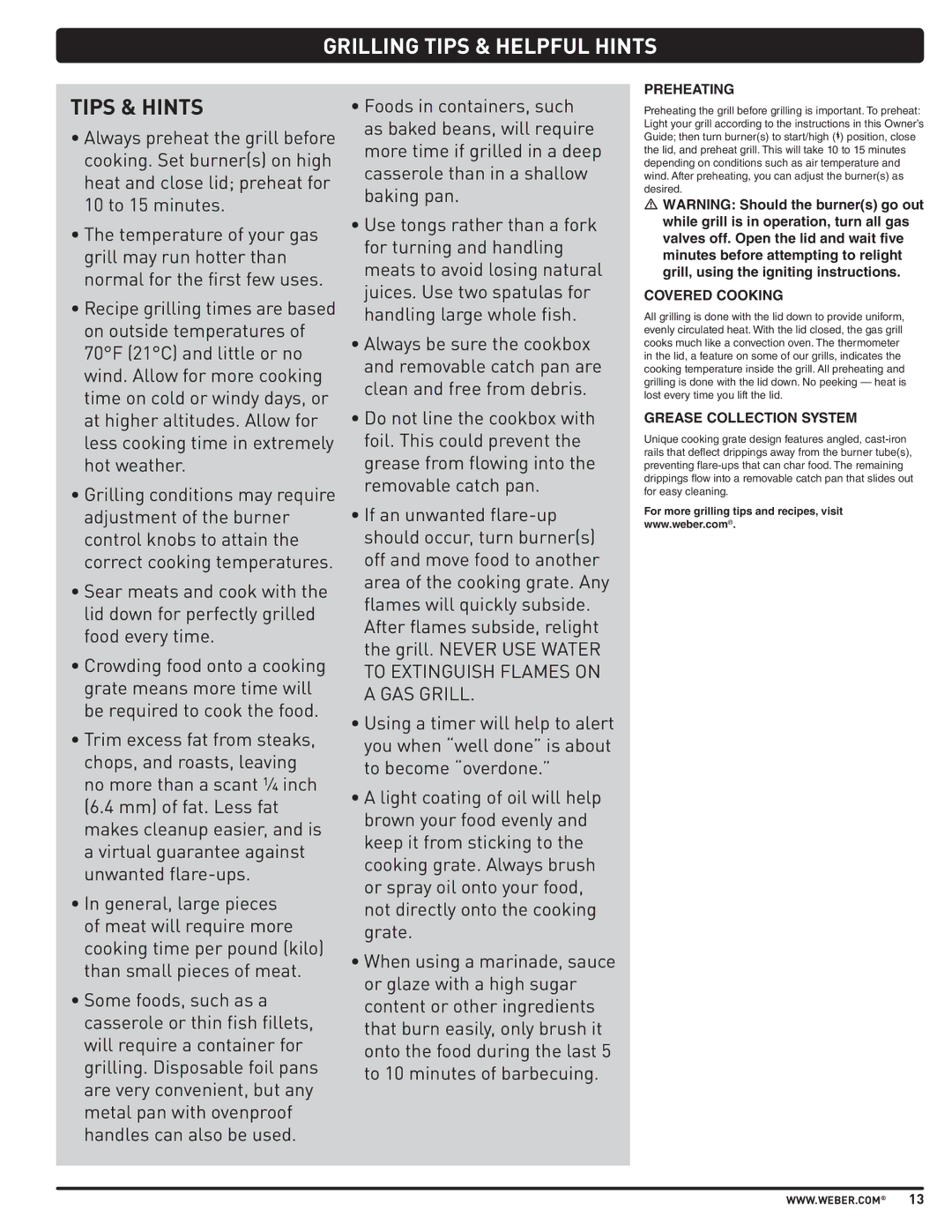
GRILLING TIPS & HELPFUL HINTS
TIPS & HINTS
•Always preheat the grill before cooking. Set burner(s) on high heat and close lid; preheat for 10 to 15 minutes.
•The temperature of your gas grill may run hotter than normal for the first few uses.
•Recipe grilling times are based on outside temperatures of 70°F (21°C) and little or no wind. Allow for more cooking time on cold or windy days, or at higher altitudes. Allow for less cooking time in extremely hot weather.
•Grilling conditions may require adjustment of the burner control knobs to attain the correct cooking temperatures.
•Sear meats and cook with the lid down for perfectly grilled food every time.
•Crowding food onto a cooking grate means more time will be required to cook the food.
•Trim excess fat from steaks, chops, and roasts, leaving no more than a scant ¼ inch (6.4 mm) of fat. Less fat makes cleanup easier, and is a virtual guarantee against unwanted
•In general, large pieces of meat will require more cooking time per pound (kilo) than small pieces of meat.
•Some foods, such as a casserole or thin fish fillets, will require a container for grilling. Disposable foil pans are very convenient, but any metal pan with ovenproof handles can also be used.
•Foods in containers, such as baked beans, will require more time if grilled in a deep casserole than in a shallow baking pan.
•Use tongs rather than a fork for turning and handling meats to avoid losing natural juices. Use two spatulas for handling large whole fish.
•Always be sure the cookbox and removable catch pan are clean and free from debris.
•Do not line the cookbox with foil. This could prevent the grease from flowing into the removable catch pan.
•If an unwanted
•Using a timer will help to alert you when “well done” is about to become “overdone.”
•A light coating of oil will help brown your food evenly and keep it from sticking to the cooking grate. Always brush or spray oil onto your food, not directly onto the cooking grate.
•When using a marinade, sauce or glaze with a high sugar content or other ingredients that burn easily, only brush it onto the food during the last 5 to 10 minutes of barbecuing.
PREHEATING
Preheating the grill before grilling is important. To preheat: Light your grill according to the instructions in this Owner’s Guide; then turn burner(s) to start/high (![]() ) position, close the lid, and preheat grill. This will take 10 to 15 minutes depending on conditions such as air temperature and wind. After preheating, you can adjust the burner(s) as desired.
) position, close the lid, and preheat grill. This will take 10 to 15 minutes depending on conditions such as air temperature and wind. After preheating, you can adjust the burner(s) as desired.
mWARNING: Should the burner(s) go out while grill is in operation, turn all gas valves off. Open the lid and wait five minutes before attempting to relight grill, using the igniting instructions.
COVERED COOKING
All grilling is done with the lid down to provide uniform, evenly circulated heat. With the lid closed, the gas grill cooks much like a convection oven. The thermometer in the lid, a feature on some of our grills, indicates the cooking temperature inside the grill. All preheating and grilling is done with the lid down. No peeking — heat is lost every time you lift the lid.
GREASE COLLECTION SYSTEM
Unique cooking grate design features angled,
For more grilling tips and recipes, visit
www.weber.com®.
WWW.WEBER.COM® 13
